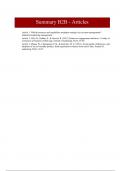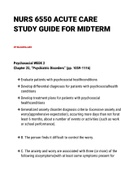Article 1: Which resources and capabilities underpin strategic key account management?
Industrial marketing management
Article 2: Gill, M., Sridhar, S., & Grewal, R. (2017). Return on engagement initiatives: A study of
a business-to-business mobile app. Journal of marketing, 81(4), 45-66.
Article 3: Zhang, W., Chintagunta, P. K., & Kalwani, M. U. (2021). Social media, influencers, and
adoption of an eco-friendly product: field experiment evidence from rural China. Journal of
marketing, 85(3), 10-27.
, 1
Article 1: Which resources and capabilities underpin strategic key account
management? Industrial marketing management
Key account management (KAM) supports the profitability and financial sustainability of firms in
business-to business markets.
Introduction
Difficult market conditions, changes in customer needs, and the reshaping of business practices
through new technologies are making business-to-business (B2B) marketing and sales
complex.
Key account management (KAM) can build and sustain competitive advantage through the
establishment of valuable long-term relationships with B2B customers.
KAM approach is organization-to organization and team-based in that it requires integrated
processes and cross-functional teams configured at the organizational level.
Conceptual framework
Resource-based theory
The theory conceptualizes organizations as bundles of resources and capabilities that include
both tangible and intangible assets that firms use to conceive of and implement their strategy
and gain competitive advantage.
Strategy literature defines capability (or competence) as a set of “skills and resources which
enable the company to achieve superior performance” in a way that is difficult for competitors to
imitate.
Resource-based lens: defining KAM resources and capabilities
Resource: “an asset or input to production (tangible or intangible) that an organization owns,
controls, or has access to on a semi-permanent basis,”
● Tangible resources may include property, plants, equipment, financial assets, IT
systems, and personnel → Tangible resources related to KAM include assets such as
information systems with customers, key account managers, and formal organizational
structures.
● Intangible resources may include knowledge, sales orientation, customer involvement,
reputational capital, and leadership skills → intangible resources include market
knowledge, customer orientation, and senior management support.
Capability as “the ability of an organization to perform a coordinated set of tasks, utilizing
organizational resources, for the purpose of achieving a particular end result.”
● Operational capabilities constitute the building blocks of the process needed to
accomplish tasks, whereas dynamic capabilities involve higher-level activities that
enable greater payoffs – also known as ordinary or substantive capabilities are those
that enable firms to make their living by efficiently performing activities linked to routines.
→ Examples include administration, purchasing, manufacturing, and transportation.
● Dynamic capabilities enable firms to alter how they make their living; they are
higher-level activities that make operational capabilities more productive and help
reconfigure resources, especially in rapidly-changing business environments – are linked
, 2
to entrepreneurial action; examples include the orchestration of resources, adaptation of
processes, and recognition and exploitation of business opportunities → In KAM,
examples of operational capabilities could be the selection of key accounts, the
development of KAM programs, and establishment of performance metrics.
Success depends on the management of assets (e.g., people, structures) and the ability to
undertake specific tasks and processes (e.g., customer selection and account planning).
Methods
We adopted a systematic review methodology to locate, critically appraise, and synthesize
relevant, high-quality sources. The approach reduces the risk of bias through a transparent and
auditable process of systematic search and selection.
The systematic review comprises five steps: planning, searching, selection, extraction and
synthesis, and reporting.
Planning
(1) to conceptualize KAM according to the resource-based theoretical lens, (2) to identify and
classify critical KAM resources (as tangible and/or intangible) and capabilities (as operational
and/or dynamic), and (3) to investigate how those resources and capabilities have underpinned
the development of KAM research over the past 15 years.
, 3
Searching
Using the following search terms:
● (key OR major OR large OR strategic OR global OR national) AND
● (account OR customer OR client) AND
● (management OR manager)
Selection
The first selection filter was relevance, as follows:
● Papers not addressing KAM were excluded
● Papers not based on data were excluded (except for theoretical/ conceptual papers on
resource-based theory)
● Papers in which the sample was not drawn from companies with a KAM program or did
not include individual KAM workers were excluded
Two different authors scrutinized the full text of the remaining 127 papers with regard to quality
and strategic focus. These filter criteria included:
● Empirical data content and relevance
● An organizational perspective on KAM
● For conceptual papers, theoretical robustness and relevance to a resources and
capabilities perspective
Extraction and synthesis
The authors performed the extraction and synthesis of the papers using the framework
described to categorize KAM resources and capabilities.
Reporting
Present our findings
Findings
Demographics of the systematic literature review
The distribution of articles by journal shows that Industrial Marketing Management has the most
articles on KAM resources and capabilities (22), with 31% of the total.
KAM resources and capabilities in literature
The distribution is as follows: tangible resources 23.6%; intangible resources 18.8%; operational
capabilities 36.6%; and dynamic capabilities 20.9%.
, 4
Tangible resources
Key account managers
The highest ranked factors in customer perceptions of the success of their suppliers' KAM
programs are the skills, knowledge, and professionalism of their key account managers.
Weighty expectations explain why highly skilled key account managers are a rare breed and
highlight their importance in developing unique value for clients and suppliers.
Key account teams












